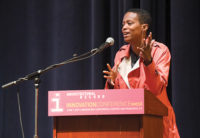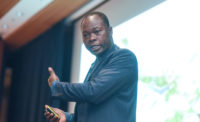Founder and principal partner of Beijing- and Los Angeles-based MAD Architects, MA Yansong, kicked off the day with a presentation of his work, which fuses the latest technology with a contemporary interpretation of traditional Asian responses to nature—from his rippling residential towers, Huangshan Mountain Village, to the dramatically rolling forms of his Harbin Culture Center, both in China. “Some say my work is futuristic,” said the architect. “But for me it is reminiscent of the canyon, the desert—something that has been there forever. I want people to experience these buildings and wonder about their place in this long history.”
Henry Cheung, who trained as an architect and is now a design director at innovation consultancy IDEO, talked about the architect’s role as visionary, asking, “How do we inject creativity into a profession that is so restricted?” But if anyone in the audience was dismayed by his sobering reminder of codes and other real-world constraints, they were quickly swept into the fantastical explorations and experimental work of David Benjamin, who presented his biodegradable mycelium brick tower installation for MoMA’s PS1 last summer; his immersive theater for musician Björk, rendered as a physical manifestation of one of her other-worldly compositions; and his intrepid work with a mussel population in New York’s East River. Sheila Kennedy, who directs material research for Boston’s Kennedy & Violich Architecture, continued the science-fiction foray with her investigations into infusing plants with nanoparticles to harvest energy and create luminescence.
Bringing the event back down to earth, Record deputy editor Suzanne Stephens moderated a panel of principals from some of the country’s—and world’s—biggest firms: Perkins+Will, HDR, and AECOM, asking how, as practices grow, they can foster greater design creativity. And Brazilian photographer, Leonardo Finotti, who was commissioned by MoMA to contribute to its current exhibition on Latin American architecture, shared his sublime images from across South America and beyond. The day concluded with San Francisco–based Anne Fougeron, who showed her award-winning work, narrating the presentation with her story—how urban context and the worlds of art and politics have inspired her modernist vocabulary. “I’m trying to compose a sense of order out of many competing things,” she said. “And trying to create buildings that will outlast us all in a world that doesn’t seem that interested in this level of quality.”
As at past Innovation conferences, the event’s participants put forward a rich variety of approaches to original problem solving in a rapidly changing world and challenged the audience by proposing new ways for considering the practice of architecture. Continuing the conversation, Architectural Record will host the next Innovation Conference in New York on October 7 in New York.













Post a comment to this article
Report Abusive Comment